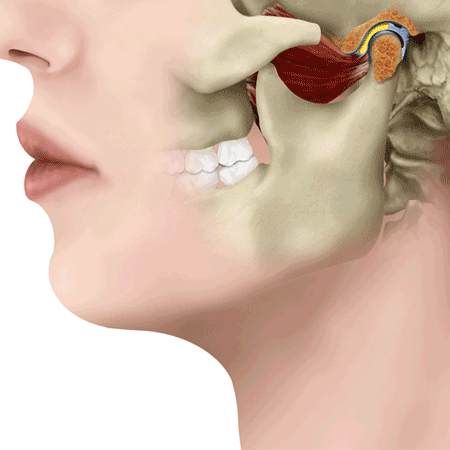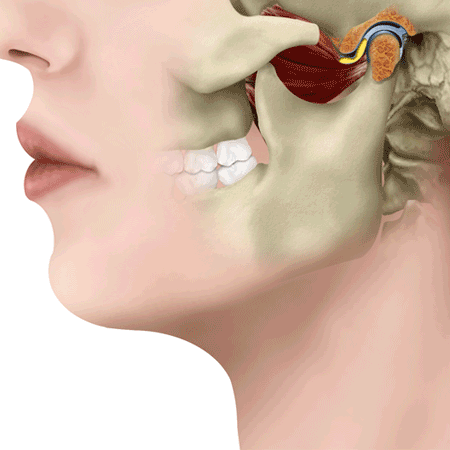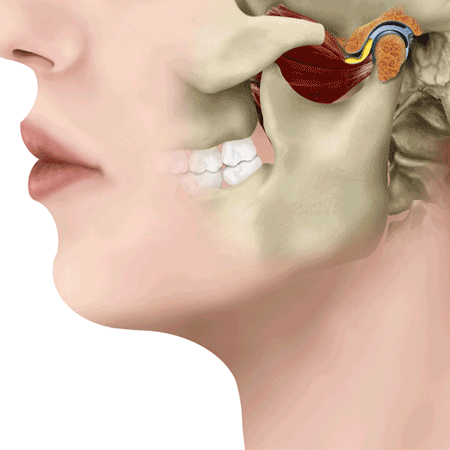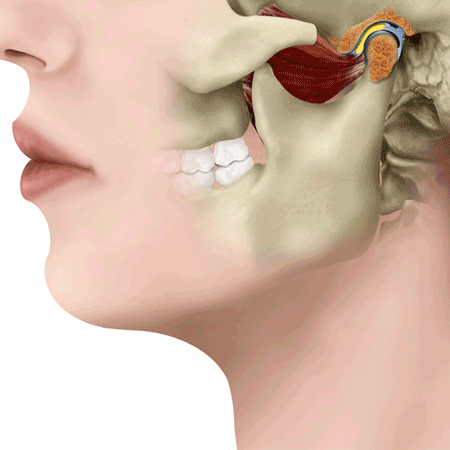Temporomandibular Joint (TMJ) and Temporomandibular Disorder (TMD)
Jaw pain has been called “TMJ” for years, so people often refer to their jaw problems as TMJ. Actually, TMJ simply means the temporomandibular joint. The TMJ is just one of the sources of temporomandibular disorders (TMD). TMD may include muscles and other structures as well as the joints.
The TMJ itself is a unique joint in many ways, but essentially it is the movable connection between the upper jaw (maxilla and temporal bones) and lower jaw (mandible). The condyle (or ball) of the joint works together with the joint fossa (or cup) in the temporal bone of the skull to guide complex jaw movements that allow opening and closing of the jaw for many important functions like chewing, talking, etc. To add even more complexity, there is a fibrous articular disc interposed between the condyle and the fossa that also moves and cushions the joint.
Diseases or dysfunction of the TMJ may include:
- Arthralgia (joint pain)
- Arthritis (inflammation or infection of the joint)
- Displacement of the articular disc
- Adhesions within the joint space
- Ankylosis or fusion of the parts of the joint limiting function
- Hypermobility
- Degenerative joint disease
- Idiopathic condylar resorption
- Neoplasms
- Developmental disorders such as hyperplasia and hypoplasia of the condyle
As mentioned earlier, problems with the joint are only part of TMD. In addition to the above there may be pain from muscles and other tissues. Whereas joint pain is commonly part of TMD, muscle pain (myalgia) is even more likely to be partially or entirely responsible for TMD.
Other Types of TMD
Some disorders not directly related to the joint include:
- Local myalgia or muscle pain at the site of the problem
- Myofascial pain (spreading or referred pain)
- Tendonitis and enthesopathy
- Myositis (inflamed muscle)
- Spasm (sudden, involuntary, and reversible contraction of the muscle)
- Contracture (shortening of the muscle fibers after radiation therapy or infection)
- Muscle hypertrophy (painless enlargement of muscles)
Adding another layer to the complexity of TMD is the common situation where two or more conditions occur together. For example, patients often have pain from the jaw muscles, the tendons, and the joint simultaneously.
Symptoms of TMD
Symptoms of TMD range from mild and infrequent to severe and debilitating. A person suffering from TMD may have one or more of the following:
- Ear pain, muffled hearing, or ringing/buzzing in the ears
- Popping or grinding noises in the jaw
- Inability to open or close the mouth comfortably
- Locking of the jaw when trying to open or close the mouth
- Headaches, neck pain, shoulder pain, or back pain
- A sudden change in the bite
- Swelling in the face
- Dizziness
Causes of TMD
There are many possible causes of TMD and often there is no known cause. Sometime patients report just waking up in the morning with jaw pain. However, there are some known causes and contributing factors to developing TMD:
- Trauma
- Direct trauma to the jaw or TMJ from impact
- Indirect trauma such a whiplash with no direct blow to the face
- Microtrauma from continuous or repetitive over-function from poor posture or habits such as clenching or grinding teeth
- Emotional trauma. Significant life events may precipitate TMD
- Pathophysiologic local and systemic factors
- Possible local factors
- Chewing efficiency
- Association between a patient’s bite and TMD has not been shown thus treatments that make permanent changes to the bite (occlusion) are rarely recommended
- Articular disc derangements
- Neck muscle hyperactivity
- Peripheral sensitization
- Central sensitization
- Female hormones (TMD is more common in women, but the underlying cause is unknown)
- Possible systemic factors
- Hypermobility or generalized joint laxity
- Degenerative, endocrine, infectious, metabolic, neoplastic, neurologic, rheumatologic, and vascular disorders
- Genetic and epigenetic factors
- There are inherited factors predisposing individuals to TMD
- Sleep habits or other sleep problems
- Sleeping position
- Night-time bruxism (grinding) and other movement disorders
- Sleep apnea may exacerbate TMD
- Nutrition
- Gut-brain interactions
- Other
Treatment of TMD
If pain and dysfunction is mild, simple measures may be adequate to alleviate the symptoms. Home remedies may help manage TMD. Some suggestions include:
- Appy moist heat for 20 minutes, gently stretch sore muscles and then apply an ice pack to the area for 10-20 minutes.
- Rest the jaw
- Limit talking
- Eat soft foods
- Take small bites and eat slowly
- Avoid hard, crunchy, or chewy foods (avoid fresh salads for a few days)
- Avoid chewing gum
- Observe good posture especially when using a mobile device or sitting at a computer.
If the pain is severe or prolonged, and home measures fail to completely resolve symptoms, call your dentist or an orofacial pain specialist.
Specialist treatment suggestions may include one or more of the following:
- Therapeutic stretching
- Properly designed oral orthotics
- Trigger point injections
- Nerve blocks
- Short term medications to speed the recovery
In rare cases, more aggressive treatment may be suggested:
- Arthrocentesis
- Joint injections
- Arthroscopy
- Joint surgery
Diagnosis and treatment of TMD is an emerging field of medicine. This means an orofacial pain specialist may be your best source of up to date, evidence-based care.





